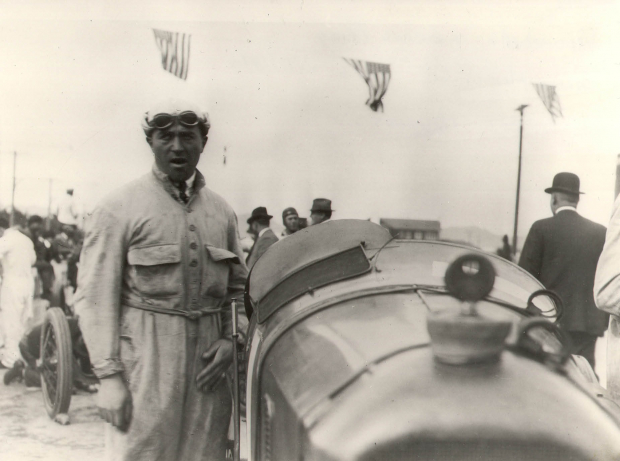The Peugeot EX3- Winner of the 1915 Vanderbilt Cup Race in San Francisco

By 1915 Peugeot had established itself as a premier automotive marques and a formidable competitor on tracks and road courses. Their L76 model had won the French Grand Prix in 1912 and the Indianapolis 500 in 1913. They returned to victory again in the 1913 French Grand Prix with a new EX3 model.
As World War I approached, Peugeot importer Alfonse Kaufman shipped an EX3 to the United States for Dario Resta, an established driver in Europe but largely unknown in the United States. The car was overhauled by the Californian mechanical genius, Harry Miller, whose cars would dominate the Indianapolis 500 and other American races during the 1920’s and 1930’s. Preparation of the car continued up to the American Grand Prize which took place two weeks prior to the Vanderbilt Cup Race in February 1915. Both races were part of the celebration of the Pan-Pacific Exposition. The Peugeot appeared at the American Grand Prize without a finishing coat of paint leaving the white primer exposed.
The Peugeot EX3 had a four cylinder engine with a bore of 3.9 inches and a stroke of 7.1 for a total displacement of 340 cubic inches. The precision design included a single iron block and integrated head, unlike previous convention which cast cylinders separately or in pairs. The crankcase was made of aluminum, a new advance in the era.
The chassis design was considered state of the art as well. Key features included lightweight wire wheels and an innovation called “integral flange” hubs to attain new levels of efficiency in speedy service for wheel changes. Like its predecessor the L76, the EX3 was admired for its streamlined bodywork and long tail which help stabilize its handling at high speeds.
The EX3’s tenure on the American racing scene was brief but hugely successful. Not only did the EX3 – in the hands of Resta – win the 1915 Vanderbilt Cup Race, but also the American Grand Prize Race. Resta, however, would move to the newer EX5 for the remainder of the 1915 season and 1916 as well.
This 37-second newsreel clip shows Resta winning in San Francisco in the Peugeot EX3.
Off-Topic: Friends, Roz and I went on a road trip with the Mets to St. Louis over the weekend. Hats off to the good-natured Cardinal fans for being so friendly...even with our "Let's Go Mets" chants and my ever-present Met flag. Here is a PDF of Mets' amazing 20-inning win over the Cardinals. I may be the only Met fan to attend the two longest Met games in history on the basis of time- May 31, 1964 23-inning loss to the Giants and last Saturday's game. Yes, I stayed to the very end of both games!





Comments
The EX3 and EX5 were also known, respectively, as the L56 and L45. The L45 is represented by an example in the Bothwell collection in California. It would be nice to know if any examples of the L76 or L56 still exist. There were 4 of the L45s in the 1916 Indy 500 race driven by Dario Resta, Ralph Mulford, Johnny Aitken and Charlie Merz. At this point in time, it’s probably not possible to determine which one of them is the Bothwell car. 2 of the L56s ran in the 1914 Indy 500 race driven by Jules Goux and Georges Boillot.
Hi Randy:
Thanks for the info!
Howard
It is possible to determine the lineage of the Bothwell car: it was driven in 1916 by Ralph Mulford, and owned by Lutcher Brown of Orange, Texas. Brown sold it via Ralph de Palma to Frank Book of Detroit, Michigan, who sold it to Bothwell.
It is not entirely clear who drove the car at the 1914 Grand Prix, though. Only two cars can be traced from the Grand Prix to specific American owners, namely Georges Boillot’s car which was driven by Johnny Aitken in 1916 and Jules Goux in 1919, and the spare car which was driven by Dario Resta in 1915/16 and Ray Howard in 1919. The Bothwell car may have been driven by Goux or by Victor Rigal in the Grand Prix.
The EX3 Peugeot in which Dario Resta won the 1915 Grand Prize and Vanderbilt had been brought to the US in 1914 for the Indy 500, and for Georges Boillot to drive. Ralph Mulford and Eddie Rickenbacher drove it before Resta.
Hi Michael:
Thanks for the info!
Here is a link to Eddie Rickenbacker in the Peugeot at the 1914 Corona Race:
http://www.vanderbiltcupraces.com/index.php/blog/article/profile_eddie_rickenbacker_americas_ace_of_aces_and_vanderbilt_cup_particip
Howard
Hola podrán enviarme un email para hacer una consulta tengo un peugeot entrre 1915-1917 no se que modelo es
gracias
Evelin - Puedes consultar con Howard, por favor incluir photographia del carro. El sabes mas de carros viejo. .(JavaScript must be enabled to view this email address)
Howard - Evelin owns/possesses a 1915-1917 Peugeot racer (model unknown) and seeks information/consultation about it.
Hello,
I’m a Peugeot fan
here are two articles on the winner of Dieppe
https://gallica.bnf.fr/ark:/12148/bpt6k98059257/f9.item
http://cnum.cnam.fr/CGI/gpage.cgi?p1=553&p3=P575.10%2F100%2F896%2F0%2F0
Thank you for your article
hello some pictures of the engine of the L76 winner at Dieppe 1912